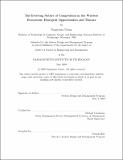| dc.contributor.advisor | Michael Cusumano. | en_US |
| dc.contributor.author | Venna, Nagarjuna | en_US |
| dc.contributor.other | System Design and Management Program. | en_US |
| dc.date.accessioned | 2010-05-27T14:15:10Z | |
| dc.date.available | 2010-05-27T14:15:10Z | |
| dc.date.copyright | 2009 | en_US |
| dc.date.issued | 2009 | en_US |
| dc.identifier.uri | http://hdl.handle.net/1721.1/55300 | |
| dc.description | Thesis (S.M.)--Massachusetts Institute of Technology, System Design and Management Program, 2009. | en_US |
| dc.description | This electronic version was submitted by the student author. The certified thesis is available in the Institute Archives and Special Collections. | en_US |
| dc.description | Cataloged from student submitted PDF version of thesis. | en_US |
| dc.description | Includes bibliographical references. | en_US |
| dc.description.abstract | By the end of 2008, there are over 4 billion mobile cellular subscriptions worldwide, translating into a penetration rate of 61%. In developed economies like the United States, the penetration rate has reached over 85%. Even though the subscriber numbers are reaching saturation levels, the revenues of mobile operators continue to grow at a double-digit rate. This is primarily because of an increase in data usage over cellular networks. Mobile handsets have become increasingly powerful and rival the capabilities of personal computers from just a few years ago. These devices can be used to run a variety of applications and are fast becoming the medium of choice for accessing the Internet. Cellular networks are also becoming increasingly powerful in their ability to carry large amounts of data. This evolution in capabilities has attracted a variety of new players to the wireless ecosystem changing the nature of interaction within the ecosystem. The central role played by the wireless operators is increasingly challenged by these new entrants creating both new opportunities and new threats for all the participants in the ecosystem. This thesis will explore the structure of the wireless ecosystem as it exists today and analyze how competition between various layers and within each layer has played out. Further, it will look at the new ways in which the participants are competing with each other and how this results in emergent opportunities and threats. Finally, the thesis will draw lessons from the Internet revolution and the personal computing ecosystem to predict how the platform wars are likely to play out and who has the opportunity to become the dominant player in the new ecosystem. | en_US |
| dc.description.statementofresponsibility | by Nagarjuna Venna. | en_US |
| dc.format.extent | 62 p. | en_US |
| dc.language.iso | eng | en_US |
| dc.publisher | Massachusetts Institute of Technology | en_US |
| dc.rights | M.I.T. theses are protected by
copyright. They may be viewed from this source for any purpose, but
reproduction or distribution in any format is prohibited without written
permission. See provided URL for inquiries about permission. | en_US |
| dc.rights.uri | http://dspace.mit.edu/handle/1721.1/7582 | en_US |
| dc.subject | System Design and Management Program. | en_US |
| dc.title | The evolving nature of competition in the wireless ecosystem : emergent opportunities and threats | en_US |
| dc.type | Thesis | en_US |
| dc.description.degree | S.M. | en_US |
| dc.contributor.department | System Design and Management Program. | en_US |
| dc.identifier.oclc | 612307138 | en_US |
